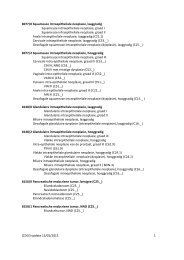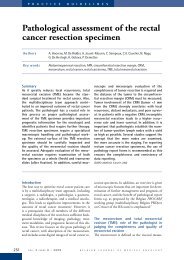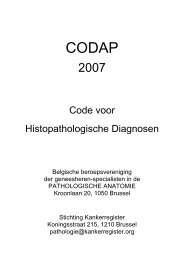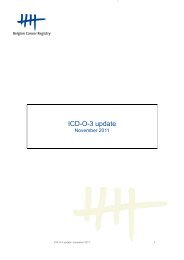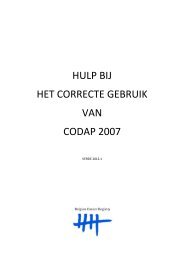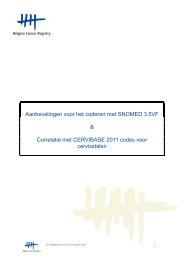Assurance de qualité pour le cancer rectal – phase 2 ...
Assurance de qualité pour le cancer rectal – phase 2 ...
Assurance de qualité pour le cancer rectal – phase 2 ...
You also want an ePaper? Increase the reach of your titles
YUMPU automatically turns print PDFs into web optimized ePapers that Google loves.
46 PROCARE <strong>–</strong> <strong>phase</strong> 2 KCE reports 81Figure 12. Per-centre-analysis (n = 124) of APR and Hartmann’s procedure(administrative cohort) $ .100350903008070250Proportion (%)60504030200150100Number of patients (N)20105000$ The weighted mean is presented with a red bar, the unweighted mean is presented with a bluehorizontal line. The grey bars represent the QI value per centre, whi<strong>le</strong> the blue dots representthe number of patients per centre. These results are preliminary, and cannot be used to judge thequality of care.Proportion of patients with stoma 1 year after sphincter-sparingsurgeryDEFINITIONNumerator: all patients with RC un<strong>de</strong>rgoing sphincter-sparing radical surgery with orwithout a temporary stoma at primary resective surgery, and still having this stoma 1year after surgery.Denominator: all patients with RC un<strong>de</strong>rgoing sphincter-sparing radical surgery with orwithout a temporary stoma.Exclusion:• patients not un<strong>de</strong>rgoing sphincter-sparing radical surgery• patients dying within one year after sphincter-sparing surgeryRESULTSDue to variab<strong>le</strong> follow-up dates in the PROCARE database and a too unspecific variab<strong>le</strong>in the data entry, a calculation at 1 year of this QI is impossib<strong>le</strong>. Therefore, the QI is notmeasurab<strong>le</strong> for the prospective cohort at present.In the administrative cohort, 3692 patients were i<strong>de</strong>ntified un<strong>de</strong>rgoing sphincter-sparingsurgery (SSO) (no information was availab<strong>le</strong> for 78 patients) (Tab<strong>le</strong> 35). Of these, 1504patients had stoma surgery or the use of stoma material within one year after SSO.Within one year after SSO, 194 of these 1468 patients died. Of the remaining 1310patients, no information was availab<strong>le</strong> on stoma closure or the use of stoma material for217 patients (total missings: 295/7074, 4%). Of the 1093 patients with availab<strong>le</strong>information (<strong>de</strong>nominator), 292 still had a stoma after 1 year (27%).Importantly, based on the administrative co<strong>de</strong>s for stoma material, it is impossib<strong>le</strong> todistinguish patients with an i<strong>le</strong>o/colostomy from patients with a urostomy. Therefore,the result may be slightly overestimated.



